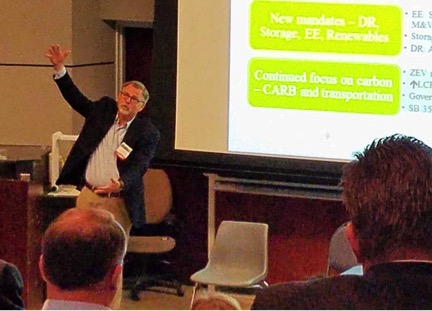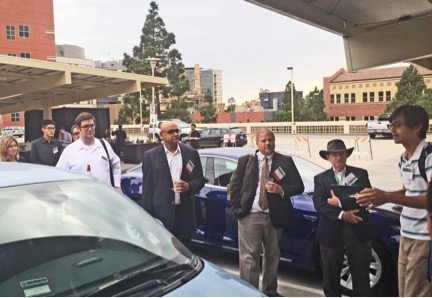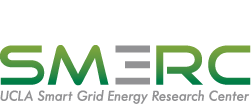
September 20, 2016

Above: Professor Rajit Gadh of UCLA SMERC, listens to Tom Doughty of California ISO.
Meeting at UCLA's historic Boelter Hall of Engineering, in the UCLA Henry Samueli School of Engineering and Applied Sciences, set the stage for innovations and demonstrations.
The utility industry is changing dramatically. Increasing supplies of renewable energy, improved "demand response" technologies, as well as energy storage in bulk by utilizes and also by consumers, are all beginning to offer tremendous opportunities to assist the transformation of utilities as they adapt to a clean energy future.
In mid-September, proof that the transformative changes are well underway was shared at a kickoff meeting of the UCLA Consortium on Energy for a Smart Grid (ESmart), hosted by the UCLA Smart Grid Energy Research Center and its principal investigator, Professor Rajit Gadh.
During the kickoff meeting, Professor Gadh shared lessons learned during research and demonstration work by UCLA SMERC with the Los Angeles Department of Water and Power on their just-completed Smart Grid Regional Demonstration Project for the City of Los Angeles, which was funded by the U.S. Department of Energy.


Above: Professor Rajit Gadh of UCLA SMERC discusses bi-directional information,
power and control flows via wireless Internet within smart grids.
Another presenter at the ESmart consortium's kickoff meeting was Adrienne Grier from ComEd of Chicago, who shared details of the utility's journey to the grid of the future.
And California ISO's Tom Doughty gave a rousing presentation about the power of renewable energy transmitted via smart grids to transform our society.
"The conversion of our society to a clean energy future has never been done," Tom Doughty reminded during his talk. "And every one of us, whether we're in the utility space, the scholastic academic space, or in an entrepreneur space, are trying to forge a new direction for an industry that has been here since Thomas Edison invented it."

Above: Peter Schwartz of the Lawrence Berkeley National Laboratories explains LBNL modeling of the potential for cost-competitive Demand Response (DR) to provide up to 6 gigawatts by 2025.
Still another interesting perspective came from Peter Schwartz of the Lawrence Berkeley National Laboratories, who spoke about technology, policy and innovation that is changing the face of smart grids and pointing the direction to how they can be implemented most effectively in the future.
Martha Symko Davis, the Director of Partnerships – Energy Systems Integration, at the National Renewable Energy Laboratory, shared an informative talk about NREL's strategy for their ESIF (Energy System Integration Facility) located in Golden, Colorado, just west of Denver. The U.S. Secretary of Energy Dr. Ernest Moniz hopes the ESIF will allow for "stronger partnership with manufacturers, utilities and researchers to help integrate more clean, renewable energy into a smarter, more reliable and more resilient power grid."
Moving toward that goal, Martha Symko Davis has developed over 50 partnerships with key stakeholders to address the challenges of systems integration of renewables at multiple scales.

Above: Martha Symko Davis of the National Renewable Energy Laboratory discussing energy system integration, or ESI.
Additionally, Schneider Electric's Mark Feasel presented his company's viewpoint about the new energy landscape. He noted a megatrend, the huge growth forecast for variable renewables, detailing that 50% of the new capacity additions in 2030 will be solar PV and storage, and also that a decade earlier, by 2020, the Internet of Things will connect 50 billion devices.

Above: Schneider Electric's Mark Feasel, Vice President of Schneider's Electric Utility Segment & Smart Grid, talked about the interest of over half the U.S. population in becoming "prosumers" who will produce their own power, store it at home and have smart interactions with utilities.
In addition to Los Angeles, another large California city recently demonstrated implementations of smart grid tech. Jim Parks of the Sacramento Municipal Utility District, shared a presentation with consortium meeting attendees. It featured SMUD's lessons learned during their smart grid regional development project funded by the DOE. Jim noted that integrating distributed energy resources, such as solar panel arrays, into SMUD's power distribution system, will be key to the utility meeting California's 2050 carbon goal of then having 80% lower emissions than a 1990 baseline level.

Above: Sacramento Municipal Utility District's Jim Parks discusses California's strong push for DER development and integration. Here he illustrates the growth in Zero Emission Vehicles (ZEVs) in the state. The prediction is that they will amount to 2.3 million vehicles as a result of California's mandate requiring automakers who sell in the state to make available to consumers a percentage of ZEVs.
The goal of the UCLA ESmart Consortium is to develop advanced technology, prototypes, demonstrations, and innovative products in the areas including, but not limited to, smart grids, microgrids, grid-connected electric vehicles and autonomous electric vehicles, demand response, renewable energy - including solar and wind - integration, battery energy storage system (BESS) integration, smart appliances, smart homes and buildings, Internet of Things (IOT) and Distributed Energy Resources (DER).

Above: UCLA SMERC's Project Lead for Electric Vehicle and Renewable Energy Integration Dr. Peter Chu discusses the solar PV array connected to a battery energy storage system (BESS) that provides power for EV chargers designed and built by SMERC. In addition to being deployed here on the roof of the campus' Parking Structure 9, SMERC EV chargers are deployed throughout UCLA's parking structures. They've provided data back to the research center's control system about charging characteristics of electric vehicles.
This will enable achievement of a Modern Grid with greater amounts of solar and wind renewable energy resources, larger numbers of electric vehicles and batteries for energy storage, a more efficient, resilient, reliable and safe electric power grid, and one that serves the needs of the 21st Century customer.
Research of the ESmart Consortium leverages the infrastructure and knowledge base that has resulting from over $15 million dollars of UCLA SMERC funded research to over the last five years during participation in the DOE Smart Grid Regional Demonstration with the Los Angeles Department of Water and Power, work for the Korea Institute for Energy Research, as well as for the Electric Power Research Institute, and the California Energy Commission.

Above: UCLA SMERC postdoc Ching-Yen Chung discusses his work on the solar powered EV chargers designed and built by SMERC that are deployed throughout UCLA's parking structures, including in this photo on the roof of Parking Structure 9. The campus' co-gen facility is visible in the middle-background.
ESmart is directed by the ESmart management team led by Dr. Rajit Gadh (Director/PI) and by three other UCLA faculty members/senior researchers. Members of the ESmart Consortium have the opportunity to advise on the research topics and technology development through representation on the consortium's advisory board.
All corporations and organizations with interest in ESmart research areas are eligible for membership. The ESmart Management Team may, subject to U.S. and State of California law and University of California policy, change or make exceptions to the eligibility criteria.
Back to News | 
